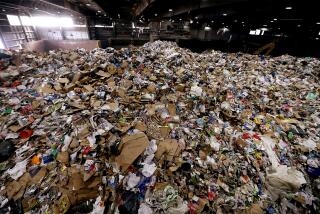Finding Your Way Around the Clutter
- Share via
If you’re the type who saves the little plastic bars that socks hang on in the store with the idea of using them to rehang the socks after separating them into cottons and synthetics, dress and casual, recently purchased and aging, darkest to lightest, then placing little pieces of white tissue between them before hanging them up on the special custom-made rack in your closet, go back to the comics page and lighten up. You are a bedrock compulsive, and you don’t need to read the rest of this column. You already have embraced every tip that follows and have refined it to niggling perfection.
Even Tina Pulice, who may be the most organized human in Orange County, is probably a piker compared with you. She claims she knows how to easily locate only 98% of all the items in her house and garage, which is a pretty sorry number for those of you who amuse yourselves by memorizing the location of every item in the Library of Congress.
So, you with the twitchy eyes counting the number of pages in this section: take a breather. This is for the rest of us incompetents who couldn’t find our car in the garage if it were parked there with the engine running.
Let’s get back to Tina. She’s a housewife from Garden Grove who occasionally teaches classes on household organization, and by all appearances she’s become awfully good at it. Evidence: she’s been married for 20 years and has two teen-age children and can still quickly find the doodles they made when they were in second grade. She and her family have moved four times since she was married, “and the more times I did it, the faster and better I got” at organizing the house.
If there is a single, basic rule of household organization by the Pulice Method, itis this: be merciless. If you don’t think you need it, you probably don’t. Pitch it out. The less you have to keep track of, the better.
(At this point, it might be a good idea to find a recording of George Carlin’s “Stuff” routine and listen to it a couple dozen times before going on. It will inspire you.)
Pulice says she begins with four big trash bags or boxes, labeled thus: put away, give away, throw away and maybe. Only the “put away” items and some of the “maybes” are keepers. The rest goes.
“Be brutal,” she says. “Ask yourself if you really need it. When was the last time you used it? Or should it be stored someplace else?”
She recommends starting somewhere near the front door on this stuff-collecting odyssey, where the stuff is thinnest, and ending in the kitchen, where it thickens up considerably. Childrens’ rooms also can be treacherous, and it can be an advantage to enlist the kids’ help, said Pulice. But, she said, kids often have a tendency to want to keep absolutely everything.
A second, nearly ironclad rule: label everything that isn’t obvious. Pulice stores lots of items in shoe boxes and coffee or nut cans decorated with contact paper but says that won’t help if you have no idea what’s in them. Stackable plastic bins and wicker baskets, which also work well for storage under the bed, also should be labeled, she said. And it’s always good to have the time-honored “junk” box to hold the items that don’t seem to have a home anywhere else.
Once all the stuff is boxed, bagged, basketed and organized, a third rule applies: when you put it away in the closet or on shelves, place the items that you most use in the front. And if you can get along without something for a prolonged time, it might be a good idea to store it elsewhere--the garage, for instance.
If you do use the garage for extensive storage, however, Pulice said, it’s essential to get as much of the stuff off the floor and onto the walls as possible. Store things on shelves, pegboards or in rafters, and label and even number the boxes for future reference. Garage items that are used often--sports equipment and picnic gear, for instance--can be stored for easy access in snap-lid trash cans.
So, OK. You’ve got it all put away. Everything’s labeled. The house is spotless and roomy for the first time this decade. But you realize you need the chafing dish that you usually only use at Christmastime. You packed it away somewhere, you’re sure. But where? You panic. Has the Pulice method failed you?
Nope, not if you’ve spent a little time on one last step: producing a card file.
This is a bit like your own personal Dewey Decimal System. The idea is to separate the card file into entries such as “garage” or “kitchen utensils” and simply write down where they are. Pulice’s “garage” file is annotated by the numbers she has written on the boxes stored there. Card No. 15, for instance, lists everything in that particular box.
The card file, says Pulice, can contain nearly anything that you deem important to household organization--lists of gifts, size and type of appliance replacement parts, serial numbers of electronic equipment, where the emergency supplies are (and what they are). Hers even has a label from a Hormel chili can, with beans, to remind her that her husband likes his chili that way.
All of this is great advice, but it tends to shame those of us who are borderline slobs. I, for example, have no idea what has become of the cherry pitter I got for my 30th birthday. But I know exactly where my card file is. It’s . . .
Well, it’s somewhere.


